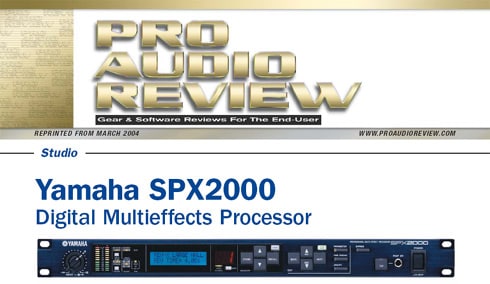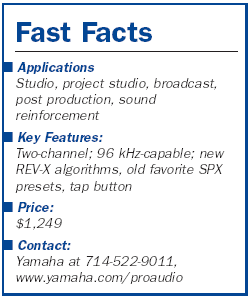SPX2000 (Pro Audio Review , March 2004)
By Russ Long FEATURE The rear panel of the 1RU, 14.67-inch deep SPX2000 provides all of the box's interface options. A pair of female XLR connectors and a pair of 1/4-inch TRS jacks provide analog input and a pair of male XLR connectors and a second pair of 1/4-inch TRS jacks provide analog output. The input and output level switches select either +4 dB or -10 dB operation. Two XLR connectors (one male and one female) provide AES/EBU digital I/O. A BNC connector accepts word clock input allowing the box to be clocked from an external source. Also, MIDI In, MIDI Out/Through and USB To Host connectors are provided for remote control and data management (via digital consoles, computers or any MIDI device). While making use of the standard interface and common programs of its predecessors, the SPX2000 introduces a new dimension of sound quality with the new REV-X reverb algorithm and the 96 kHz audio DSP. The SPX2000 features three memory banks: Preset, Classic and User. The Preset bank contains 97 programs (17 are based on the new REV-X reverb algorithms). The REV-X is a whole new generation of Yamaha reverb programs that feature a rich reverberation tone and smooth decay. These algorithms include the REV-X Hall, REV-X Room and REVX Plate algorithms and feature higher definition parameters such as ROOM Size and Decay.
The other 80 presets include the popular trademark SPX programs such as gated reverbs, pitch effects, delays, modulation and other special effects. All of the programs went through a refined editing process by top engineers. The CLASSIC bank consists of 25 classic SPX programs identical to several of the original SPX90 presets. The USER bank provides storage for 99 user programs. The SPX2000 is extremely easy to navigate. The box's parameters are sorted in three groups: Parameter, Fine Param and Utility. The box also includes other dedicated buttons like Undo, Compare, Bank, Mode, Meter, Tap and Bypass to ensure quick and efficient operation. The box's familiar display offers two lines of 16 characters but new to the SPX2000 are five assignable LCD back colors. The user programs can have any of the five colors assigned to them. The preset programs are colored by effect groups giving you an instant recognition of the effect type (cyan: reverbs, white: delays, magenta: pitch and modulations, yellow: others, green: Classic Bank). Red is reserved for warning messages. The SPX2000 Operation Lock function provides three security levels, from preventing accidental changing of Utility settings, or protecting stored memories to prohibiting almost all operations. Also on the front panel is a foot switch connector which allows effect tempo adjustment to be entered via a foot switch. The SPX2000 Editor (slated to release by the time you are reading this) provides computer controlled editing, data management, and remote control capability using the same environment and common interface as the Studio Manager for Yamaha Digital Consoles. This free download is available from www.yamahaproaudio.com and supports both Mac OS X and Windows systems. IN USE I compared the SPX2000 to the reverb presets in several of the plug-ins in my ProTools rig and was impressed at how much better the SPX2000 sounded in almost every instance. By using the digital I/O the SPX2000 interfaces flawlessly with my ProTools system adding a whole new dimension of effect options without using any of my system's DSP. Many of the DAWs that I work on have limited DSP so a box like the SPX2000 can vastly improve the sound potential of a system without gobbling up valuable computer processing cycles. I found the new REV-X reverb algorithms to sound stunning. I experimented with all of the presets on vocals, guitars, percussion, drums and keyboards and was amazed. Unlike so many boxes that only offer one usable preset for every 20 filler patches, the bulk of the SPX2000 programs are very usable. I found the REV-X Wood Room preset to be my favorite drum preset. It does a fantastic job of creating a natural space that sits extremely well in a mix. On vocals, I had wonderful results with the Vocal Chamber and the REV-X Vocal Plate programs. Besides being very natural sounding, I found that both presets have an amazing depth that adds a new dimension to the vocal performance. I also found that the delays worked very well with vocals and electric guitars. It is always refreshing to see an effects box with a couple of mono delay programs. I get so tired of the boxes that require you to duplicate all of the parameters of both the left and right channels to create a mono delay. I also found that several of the pitch-oriented presets worked very well on backing vocals (e.g. Stereo Pitch, Symphonic, Classy Glassy). The tap button is a handy feature when setting up parameters on delay and echo programs. SUMMARY Russ Long, a Nashville-based producer/engineer, owns The Carport recording studio. He is a regular contributor to Pro Audio Review. Copyright 2004 IMAS Publishing (USA), Inc. Reprinted with permission. Reprinted from Pro Audio Review |


